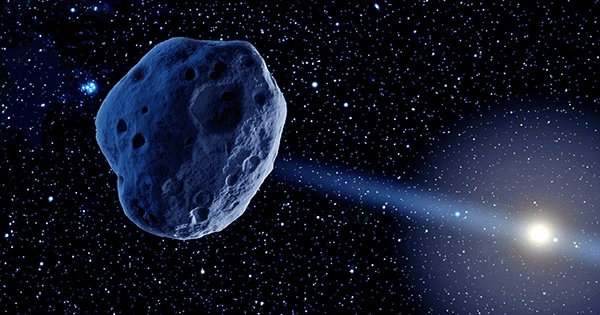An asteroid detection algorithm meant to find near-Earth asteroids for the Vera C. Rubin Observatory’s forthcoming 10-year night sky survey has discovered its first “potentially hazardous” asteroid, a word for space rocks in Earth’s orbit that astronomers prefer to keep an eye on.
The 600-foot-long asteroid, dubbed 2022 SF289, was detected in Hawaii during a test run of the algorithm with the ATLAS survey. The discovery of 2022 SF289, which poses no threat to Earth in the near future, indicates that the next-generation algorithm, HelioLinc3D, can find near-Earth asteroids with fewer and more dispersed observations than current methods require.
“By demonstrating the real-world effectiveness of the software that Rubin will use to look for thousands of yet-unknown potentially hazardous asteroids, the discovery of 2022 SF289 makes us all safer,” said Rubin scientist Ari Heinze, principal developer of HelioLinc3D and a researcher at the University of Washington.

Tens of millions of stony bodies inhabit the solar system, ranging from microscopic asteroids to dwarf planets the size of our moon. These objects date back over four billion years when our solar system’s planets formed and assumed their current locations.
The majority of these bodies are far away, but a small number orbit close to the Earth and are referred to as near-Earth objects or NEOs. The closest of these—those with trajectories that bring them within 5 million miles of Earth’s orbit, or roughly 20 times the distance between Earth and the moon—require special attention. Such “potentially hazardous asteroids,” or PHAs, are deliberately sought out and monitored to ensure they do not strike Earth, which would be catastrophic.
PHAs are discovered using specialized telescope systems like as the ATLAS survey, which is managed by a team at the University of Hawaii’s Institute for Astronomy. They accomplish this by photographing portions of the sky at least four times per night. When students detect a point of light traveling unmistakably in a straight line through the image series, they make a discovery. Scientists have discovered approximately 2,350 PHAs using this method, but they anticipate that at least as many more are still to be discovered.
In early 2025, the Vera C. Rubin Observatory will join the hunt for these objects from its peak in the Chilean Andes. Rubin’s findings will significantly increase the pace of PHA discovery. Rubin’s 8.4-meter mirror and enormous 3,200-megapixel camera will scan the sky at an unparalleled rate, hitting places twice per night rather than the four times required by current telescopes.
However, with this unusual observing “cadence,” researchers will require a new sort of discovery method to reliably detect space rocks.
Rubin’s team at the University of Washington’s DiRAC Institute has been working on developing such codes. Heinze and Siegfried Eggl, a former University of Washington researcher who is now an assistant professor at the University of Illinois at Urbana-Champaign, developed HelioLinc3D, a code that could find asteroids in Rubin’s dataset, in collaboration with Smithsonian senior astrophysicist and Harvard University lecturer Matthew Holman, who pioneered a new class of heliocentric asteroid search algorithms in 2018.
Heinze and Eggl intended to test HelioLinc3D while Rubin was still being built to see whether it could find a new asteroid in the data that was already available but had too few observations for current conventional methods to find.
ATLAS astronomers John Tonry and Larry Denneau contributed their data for testing. The Rubin team directed HelioLinc3D to sift through this data, and on July 18, 2023, it discovered its first PHA: 2022 SF289, which was originally observed by ATLAS on September 19, 2022, at a distance of 13 million miles from Earth.
ATLAS had detected 2022 SF289 three times on four different nights, but never the required four times on one night to be classified as a new NEO. But these are the only times that HelioLinc3D shines: It made the discovery after successfully combining data fragments from all four nights.
However, HelioLinc3D demonstrates that it is possible to recover these weak objects as long as they are visible over multiple nights, according to Denneau. “Any survey will have difficulty discovering objects like 2022 SF289 that are close to its sensitivity limit,” he added. We now have a “bigger, better” telescope as a result of this.
Because 2022 SF289 was passing in front of the Milky Way’s dense starfields, other surveys had also missed it. Additional observations from Pan-STARRS and Catalina Sky Survey rapidly verified the discovery, however, as they now knew where to look. The group recovered more unrecognized observations made by the NSF-funded Zwicky Transient Facility telescope using the ADAM platform from B612 Asteroid Institute.
The NEO 2022 SF289 is an Apollo-type NEO. It comes within 140,000 miles of Earth’s orbit, which is closer than the moon. It has a 600-foot diameter, which qualifies it as “potentially hazardous.” Despite its close closeness, estimates show that it will not collide with Earth in the near future. Its discovery was announced in the Minor Planet Electronic Circular MPEC 2023-O26 of the International Astronomical Union.
Scientists currently know about 2,350 PHAs, but more than 3,000 are expected to be discovered.
“This is just a small taste of what to expect with the Rubin Observatory in less than two years when HelioLinc3D will be discovering an object like this every night,” said Rubin scientist Mario Juri, director of the DiRAC Institute, professor of astronomy at the University of Washington, and team leader for HelioLinc3D.
“However, it is a foreshadowing of the coming era of data-intensive astronomy.” From HelioLinc3D to AI-assisted codes, the next decade of discovery will be a narrative of algorithm progress as much as new, huge telescopes.”












